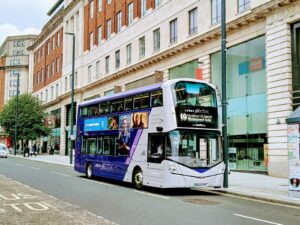Climate change has raced up the list of priorities for the public during the last year or so. MORI polls have shown that this is now at the top of the public’s concerns, sharing importance levels only achieved by Brexit, social care and the NHS
Gridserve is constructing the first of a nationwide network of over 100 Electric Forecourts® near Braintree, EssexBut there is much to do in order to meet the government’s legally binding targets of the UK being net-zero carbon by 2050. Of the key areas of electricity supply, heating and transport, progress in the latter is slower by some margin.
So, what are the answers?
Government policy is lagging behind where it should be and attracting criticism from the independent Committee on Climate Change. The automobile industry is moving ahead regardless, perhaps seeing the way the wind is blowing. Local authorities are declaring climate emergencies and introducing wide ranging local plans to achieve even more stringent targets.
More infrastructure is being delivered to facilitate EV charging but, more importantly, this is being linked to wider green agenda aims via vehicle to grid chargers. These fit EV ownership nicely into the thread of ‘homes / buildings as power stations’ in their own regard and the very definition of decentralisation. All of these will play a role in the future. Government policy looks forward to 2035 but perhaps by then the deep seated and intractable desire of the British individual to own a car at all might be starting to fade, with car clubs and shared transportation becoming the norm.
Climate Change
There is a whole international infrastructure which oversees climate change across the globe. The UNFCCC and IPCC have been saying for years that global warming is worsening and that urgent action needs to be taken. However, the IPCC report of October 2018 touched a particular nerve with the public.
This was the most hard-hitting report to date and effectively said that the world has 12 years to get a grip on global warming, or there will be irreparable damage to the world’s ecosystems and environment. From this report sprung a new vigour of climate action. Greta Thunberg and Extinction Rebellion were but two indicators of this.
More important, though, was the trend for local authorities to express their concerns through passing motions declaring a climate emergency in their areas. Bristol City Council was the first and has been followed by another 280 local Councils.
Most have chosen the date of 2030 by which they intend to be net-zero carbon and are developing action plans to support those pledges. Of the big areas of buildings, heating and transport, the latter has had less attention up to now, but this is changing. Local authorities traditionally have large fleets of vehicles. Islington Council has 500 vehicles and traditionally these would all have been driven by an internal combustion engine.
The race to make the fleet electric is well and truly on. Such commitment has not hitherto been apparent in the civic space. There is also the so-called ‘grey fleet’ which is comprised of vehicles owned by staff employed by the council. This too is a big opportunity for action.
The more progressive organisations are starting to link payment of mileage allowances to the polluting value of the car, very much as HM Treasury has done for taxation of vehicles. These policies are progressive but demonstrate the commitment to the goal.
Local authorities are also reviewing their functions and policies. Refuse collection is under consideration for moving to underground refuse systems or use of EV or hydrogen vehicles; home working policies aim to reduce commuting to work; video conferencing reduces the need to attend meetings.
Government policy
Gridserve – with a solar PV roof, the facility provides electricity back to the gridThe government has developed a policy agenda over the last decade to assist with the move towards a decentralised and decarbonised energy supply.
The remainder of the ‘4D’s’ (digitalisation and democratisation) have been less prevalent to date but this will change over time. The Road to Zero policy paper was published in July 2018 and provided a detailed insight into how the government would facilitate the transition to electric vehicles and impose a total ban on the sale of vehicles fuelled by an internal combustion engine by 2040.
This has subsequently been brought forward to 2035 and it is widely believed that this deadline will be moved again, most likely to 2030. The announcement of the move to 2035 was not unexpected but there was surprise when hybrids were also included in the ban. Also, on government policy, HM Treasury has ruled that the ‘benefit in kind’ level for EVs under tax rules will be reduced to zero this month (April 2020) which should
provide an effective fillip for the market.
Electric Vehicles
The government wants the UK to lead in the EV marketplace, by developing a strong R&D capacity and leading in innovation. The automobile manufacturers have sensed the way that public opinion on climate change is going and seen the growing support for electric cars. There has been an inevitable time lag, filled only by Tesla, but the wider industry is now catching up and a huge array of different EVs are now on sale or close to launch.
These range from the bottom of the price range to the luxury and sports brands. Car performance is improving rapidly, with newer vehicles in a different league.
Ranges of 300 miles in the summer and 250 miles in the winter are not uncommon amongst the reasonably priced new entrants. The ‘benefit in kind’ changes mentioned above will now ensure that it is cheaper to have a company electric car than a traditional model. This means that sales are likely to soar as employees switch and this also means that the second-hand market for EVs will be boosted in two to three years’ time.
Electric Vehicle Infrastructure
The Road to Zero paper recognised the need for the transition to electric vehicles to be supported by new infrastructure, principally charging stations.
There are, however, differing views on the necessity for widescale public charging to be available. In fact, most EV charging takes place at home, at least where there is a drive or space off road. This provides the most convenient and cost-effective charging and is apparently where 80% of charging takes place.
Where flat owners, or those living in terraces, cannot enjoy this privilege, other provisions have to be available. A good example is in Westminster, where lamp post chargers have been added along the entire length of Sutherland Avenue.
The government made clear early on that it had no intention of operating a charging network and saw this as industry-led. Accordingly, charging networks have been established across the country by numerous different companies.
Sadly, the VHS vs Betamax tussle seems to have reconfigured with CCS or CHAdeMO connectors for EVs, but at least the government has legislated under the Automatic Vehicles Act 2018 in relation to ceasing the necessity to have a club card to work a specific charger. Availability via a standard contactless debit card is a big step forwards.
The next challenge will be preventing overcharging for EV connection, which is shimmering on the horizon already.
The Electricity grid
Another of the impressive steps forward that the EV charging industry has demonstrated is the ability to develop faster chargers.
At home, a 3 kW or 7 kW charger may have seemed fine for an early model Leaf with a modest battery, below 30 kW capacity, but it starts to take a long time to charge up larger batteries.
Tesla has been making 100 kW battery cars for some time. The early rapid chargers on the motorway system, pioneered by Ecotricity, were 50 kW DC chargers, but these are already looking outdated. The Hyundai Kona will take 100 kW of charge, meaning that on the motorway, the car can take double the capacity that the charger is capable of distributing, thereby adding to the time.
This challenge has been risen to by others. Fastned introduced the first 350 kW charger in the UK to a station in Sunderland in a scheme funded by EU money. This is the future. The new motorway services that are not covered by the Ecotricity deal are making alternative arrangements, such as the Ionity deal in the new Skelton Lake services on the M1 in Leeds.
Again, a station with six 350 kW chargers is looking much more like it. But a window into the future is perhaps provided by the Electric Forecourt plans of Gridserve, who plan over 100 rapid charging stations across the country.
Squeezing the ‘joined up’ approach to the maximum, the company has 24 350 kW rapid chargers in what looks like a modern filling station, but with a solar PV roof, facilities to shop and rest and the ability from the facility to provide electricity to the grid and trade it. The flagship site is currently under construction in Braintree, Essex. But faster EV chargers need ever larger grid connections and the UK grid is under huge pressure as the transition trundles on towards a decentralised and decarbonised system. A side effect of this pressure is the cost of some connections.
Again, the Gridserve model shows the way. Instead of just an EV filling station providing charges to electric vehicles, the Electric Forecourt is a mini power station, linked to its own renewable energy facilities (where possible) and incorporating battery storage. This means that the station can take power from the grid when there is too much (and charge the batteries) and discharge it into the grid at peak times for premium rates (when more power is needed). As such the business case looks very different and is significantly more robust.
Is car ownership really essential?
Gridserve — facilities to shop and rest while your vehicle chargesFor a true look into the future, though, surely we need to move beyond individual car ownership. Cars cost excessive amounts of money but often stand idle for 80% of the time; they take up space; they cost to tax, insure and maintain. One of the exciting developments in energy is the move towards ‘energy as a service’. This means looking at the wider aim of something, rather than a narrow-angle.
Here, surely the wider aim is to get from A to B as easily as possible. To do this, do you need to own a car? The answer must surely be no and car clubs are now demonstrating this to be true. The idea is not new — you join the club and can then go on line and in a couple of clicks have a car available to rent by the hour. No tax, no insurance, no liabilities from ownership — just the ability to get from A to B.
Now this idea is being updated with all cars being EVs and may well end up with automated vehicles when they finally arrive. Cars on chargers when they are parked in their bays and so readily available with ample range. What is there not to like? It is difficult to pin down exactly the path that transport will take over the next twenty years. But there are enough exciting developments.
Photo Credit – Pixabay
Stephen Cirell is an independent consultant on the green agenda specialising in local government and the public sector. He is author of a number of books on renewable energy, energy services companies and climate emergencies

















Ontario Market is serviced by Utility Providers HydroOne and Ontario Power Generation. TGEP’s R&D division thoroughly checks and ensures that the products that we provide you are fine tuned to be compatible with the power provided by HydroOne and OPG, that too in the most efficient way. For residential customers the stations allow them to monitor the current and to set the machines to autocharge your vehicles during non-peak hours, saving you more money.